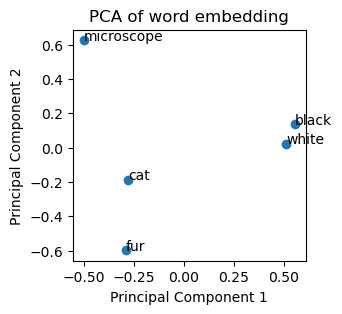Word embeddings#
Note: This page is deprecated. See Text embeddings for the updated notebook.
A word embedding is a high-dimensional latent space where words or phrases are represented as vectors. In this notebook we will determine the vectors for a couple of words. For visualization purposes, we will apply principal-component-analysis to these vectors and display the relationship of the words in two-dimensional space.
import openai
import numpy as np
import matplotlib.pyplot as plt
from sklearn.decomposition import PCA
This helper functions will serve us to determine the vector for each word / text.
def embed(text):
from openai import OpenAI
client = OpenAI()
response = client.embeddings.create(
input=text,
model="text-embedding-3-small"
)
return response.data[0].embedding
vector = embed("Hello world")
vector[:3]
[-0.002119065960869193, -0.04909009113907814, 0.02101006731390953]
len(vector)
1536
words = ["microscope", "cat", "fur", "black", "white"]
# Example of input dictionary
object_coords = {word: embed(word) for word in words}
# Extract names and numerical lists
names = list(object_coords.keys())
data_matrix = np.array(list(object_coords.values()))
# Apply PCA
pca = PCA(n_components=2) # Reduce to 2 components for visualization
transformed_data = pca.fit_transform(data_matrix)
# Create scatter plot
plt.figure(figsize=(3, 3))
plt.scatter(transformed_data[:, 0], transformed_data[:, 1])
# Annotate data points with names
for i, name in enumerate(names):
plt.annotate(name, (transformed_data[i, 0], transformed_data[i, 1]))
plt.title('PCA of word embedding')
plt.xlabel('Principal Component 1')
plt.ylabel('Principal Component 2')
plt.show()

Exercise#
Draw an embedding for words such as “segmentation”, “thresholding”, “filtering”, “convolution”, “denoising”, “measuring”, “plotting”.
Could you predict how the words are placed in this space?
Draw the same embedding again - is the visualization repeatable?
Change the order of the words in the list. Would you expect the visualization to change?
Add words such as “banana”, “apple”, “orange”. Could you predict the view?
